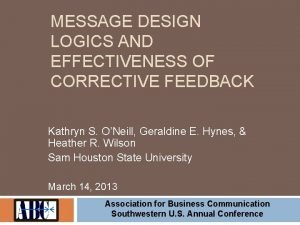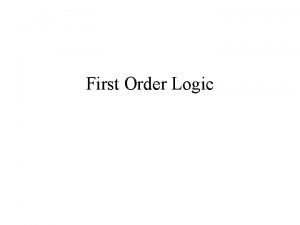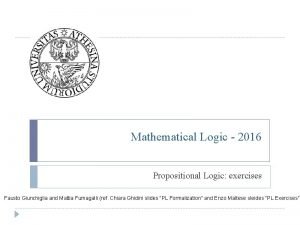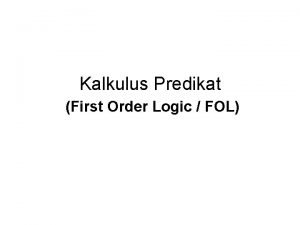Mathematical Logic 2016 Exercises First Order Logics FOL






- Slides: 6

Mathematical Logic - 2016 Exercises: First Order Logics (FOL) Originally by Alessandro Agostini and Fausto Giunchiglia Modified by Fausto Giunchiglia, Rui Zhang, Vincenzo Maltese and Mattia Fumagalli

DPLL 2

DPLL Procedure: Main Steps 1. It identifies all literal in the input proposition P B ¬C (B ¬A C) (¬ B D) 2. It assigns a truth-value to each variable to satisfy them B ¬C (B ¬A C) (¬ B D) ν(B) = T; ν(C) = F 3. It simplifies P by removing all clauses in P which become true under the truth-assignments at step 2 and all literals in P that become false from the remaining clauses (this may generate empty clauses) D 4. It recursively checks if the simplified proposition obtained in step 3 is satisfiable; if this is the case then P is satisfiable, otherwise the same recursive checking is done assuming the opposite truth value (*). D 3 YES, it is satisfiable for ν(D) = T. NOTE: ν(A) can be T/F

DPLL Procedure: Example 1 P = A ∧ (A ∨ ¬A) ∧ B q There are still variables and clauses to analyze, go ahead q P does not contain empty clauses, go ahead q It assigns the right truth-value to A and B: ν(A) = T, ν(B) = T q It simplifies P by removing all clauses in P which become true under ν(A) = T and ν(B) = T This causes the removal of all the clauses in P q It simplifies P by removing all literals in the clauses of P that become false from the remaining clauses: nothing to remove q It assigns values to pure literals. nothing to assign q All variables are assigned: it returns true 10

DPLL Procedure: Example 2 P = C ∧ (A ∨ ¬A) ∧ B q There are still variables and clauses to analyze, go ahead q P does not contain empty clauses, go ahead q It assigns the right truth-value to C and B: ν(C) = T, ν(B) = T q It simplifies P by removing all clauses in P which become true under ν(C) = T and ν(B) = T. P is then simplified to (A ∨ ¬A) q It simplifies P by removing all literals in the clauses of P that become false from the remaining clauses: nothing to remove q It assigns values to pure literals: nothing to assign q It selects A and applies the splitting rule by calling DPLL on q A ∧ (A ∨ ¬A) AND ¬A ∧ (A ∨ ¬A) which are both true (the first call is enough). It returns true 11

DPLL Procedure: Example 3 P = A ∧ ¬B ∧ (¬A ∨ B) q There are still variables and clauses to analyze, go ahead q P does not contain empty clauses, go ahead q It assigns the right truth-value to A and B ν(A) = T, ν(B) = F q It simplifies P by removing all clauses in P which become true under ν(A) = T and ν(B) = F. P is simplified to (¬A ∨ B) q It simplifies P by removing all literals in the clauses of P that become false from the remaining clauses: the last clause becomes empty q It assigns values to pure literals: nothing to assign q All variables are assigned but there is an empty clause: it returns false 12











